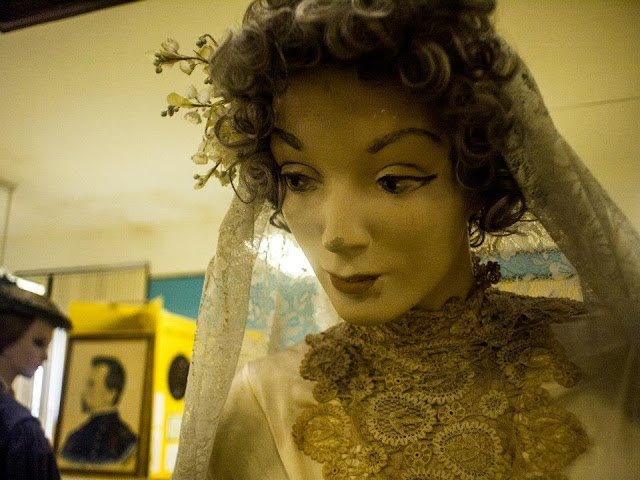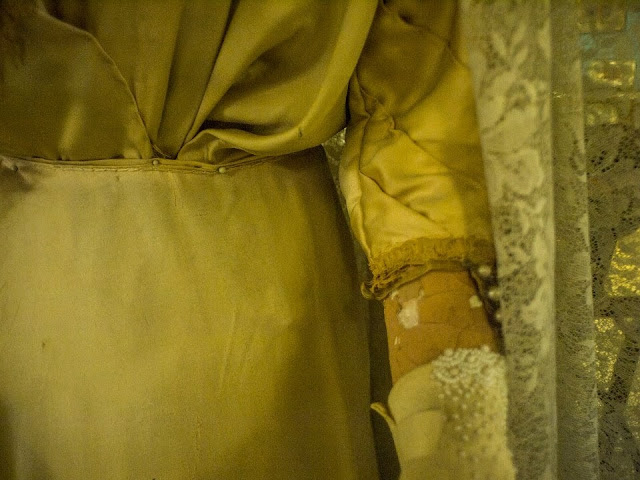Although donated by the same family that gave the 1870s green silk
bustle gown to the Kearny Museum, this 1909-14 silk and lace wedding
gown was improperly mislabeled as being part of the bride's trousseau in
1870. This wedding dress is as far from the 1870s as you could
get...elbow length pleated sleeves, lace insets, pearl and rhinestone
decoration, a slim, straight skirt with a slight train and a drapey swag
of fabric. These elements coordinate with dresses from 1909-14.
Not
only was this dress on the worst mannequin in the whole exhibit (the
most crackly skin and weirdly hunched pose), the dress had suffered some
kind of weird moisture damage, which left enormous, stiff stains and
discoloration along the back of the dress, and mold on some of the lace.
 |
| To fit the mannequin, someone had sliced up each glove (a delicate beaded cotton style) and then taped it shut. And look just how dirty those gloves were! They were covered in murky brown stains. |
 |
| The horror that awaited underneath the gloves. |
 |
| The pitifully messy and discordant "bouquet" was distracting from the elegant style lines of the gown. |
 |
| Beautiful sleeves, and beautiful bead and pearl trim! Utterly
scrumptious, but barely noticeable under that enormous piece of
synthetic lace cloth that was draped to simulate the appearance of a
veil. |
 |
| The lace "veil" was the first warning sign of unimaginable grime and moisture damage. |
 |
| The back of the gown. The awkward fit of the gown on a weirdly posed
mannequin, combined with massive, dense moisture stains. This moisture
most likely came from the enormous skylight overhead. |
 |
| Mold on the fragile lace and silk. |
 |
| Even more mold stains on the back of the skirt. |
 |
| Where the silk had absorbed the moisture, it had dried up and become
brittle to the touch, so much so that the fibers just snapped when I
touched them to examine the damage. |
 |
| The long folds of the ivory silk skirt couldn't escape from being permeated--and damaged--by this intense moisture. |
 |
| The silk experienced some stress and consequently ripped after the thread holding the hem had rotted. |
The biggest surprises in this "dress resurrection" were what I found
when I removed the dress from the mannequin. The mannequin itself was
nightmarishly horrifying; rather than an actual midsection, it had this
weird concave midsection made of a mesh material that had also soaked up
its fair share of whatever leaked through the skylight. The mannequin
also wore a short Edwardian petticoat, which was terribly stained
from--you guessed it--moisture damage. The silk lining of the dress
fared the worst in terms of damage; it was completely shattered, with
only a few threads holding down bones, hooks, and eyes.
 |
| Warning: The following images may not be suitable for children or those who are faint of heart. |
 |
| GAHHH!! What is that?!? |
 |
| All that water must've had soot or something in it, because the
mannequin's neck--and the lace neck inset--were covered in this sooty
grime. |
 |
| The heartbreaking remnants of the silk lining. |
 |
| This poor petticoat is in desperate need of a wash. |
The wedding gown is constructed in one piece. It fastens along the
left-hand side with hooks and eyes, as dresses of this period usually
do. It fastens with more hooks and eyes around the front of the armscye,
along the shoulder, and up the high lace collar. The lace collar still
has it's original stays, though they were attached with tape. The
decorative silk swag is attached at the left, swings across the waist,
and is fastened at the right side seam. I couldn't get many photos of
the inside because I wanted to handle this dress as little as possible.
 |
| The shoulder hook-and-eye closure. |
 |
| The hook-and-eye closure along the lace collar. |
 |
| The closure of the swag. And lovely decorative chainstitching!! |
I decided that the best upgrade I could give it at the moment was to
put it on one of those more modern mannequins, of which now I had a few
naked ones lying around. This display is still by now means perfect
(really due to the mannequin's awkward pose) but it still succeeds in
highlighting the actual dress, instead of swamping it in layers of
synthetic, dirty lace fabric and questionable styling choices.
 |
| However inaccurate the red hair is, it still helps this rather "ecru" side of the exhibit "pop." |
 |
| The lovely decorative swag, in full view! The subtle train is supported by some pieces of balled-up acid-free tissue paper. |
 |
| Those gorgeous sleeves are no longer smothered by that dingy lace tablecloth. |
 |
| I used the veil from the 1926 Wedding Gown
display to help conceal the stains on the back of the dress. I plan to
replace the flower crown with a decent-looking tiara from Ebay. |




























No comments:
Post a Comment